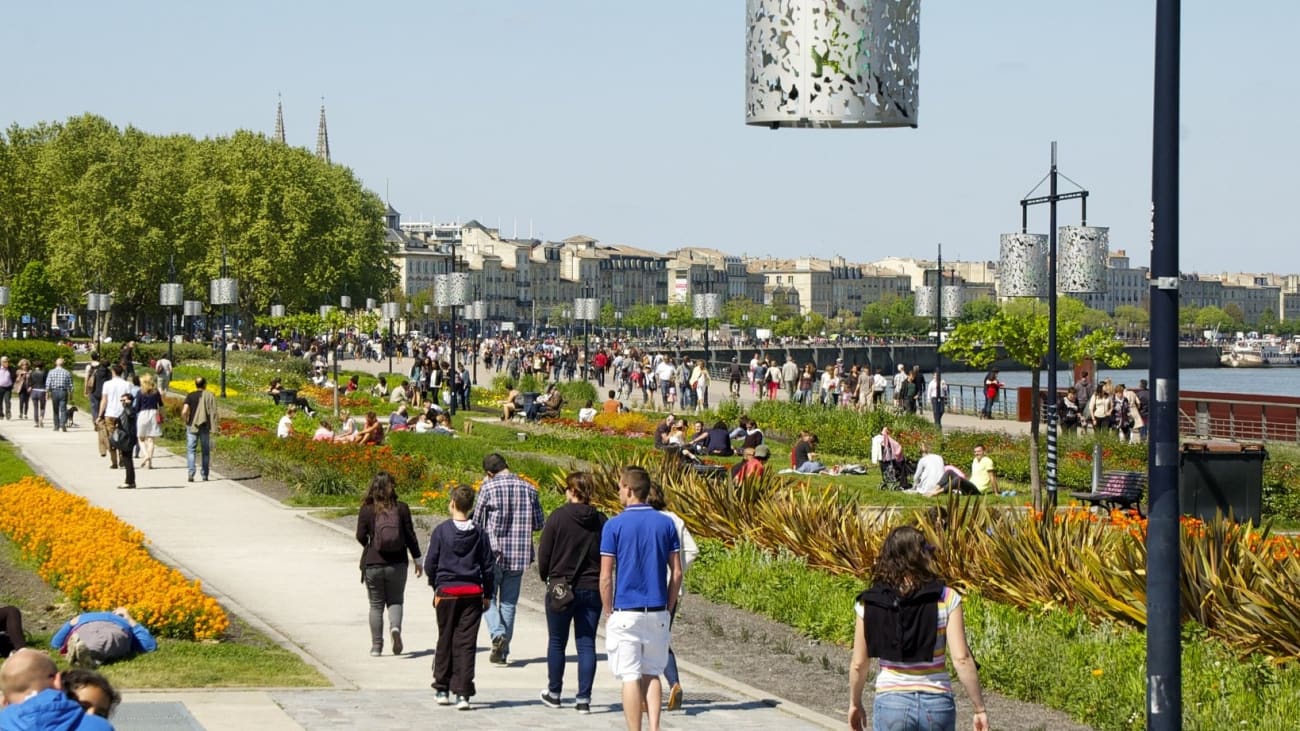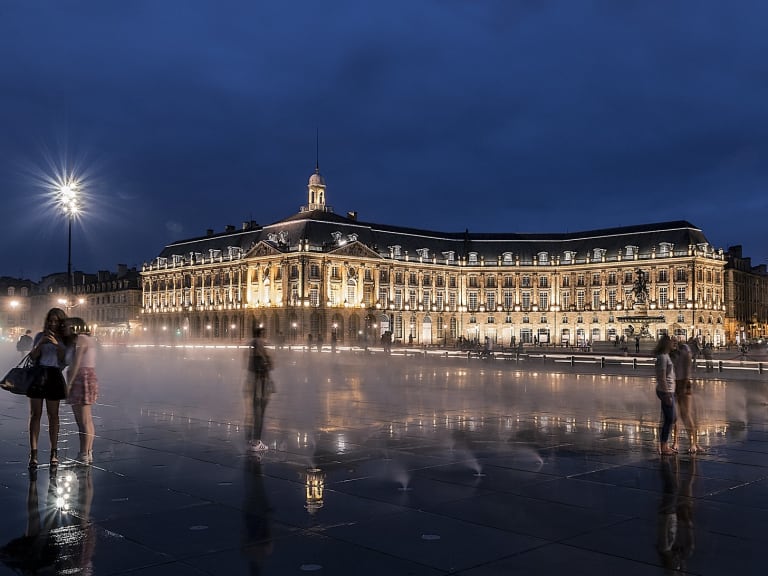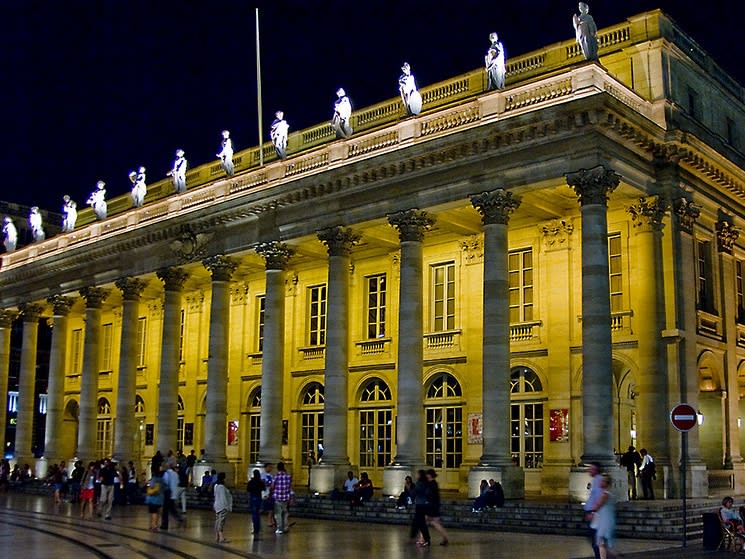Bordeaux in 3 Days: a guidebook for getting the most out of your visit
If you plan to spend 3 days in the beautiful French city of Bordeaux, here is an itinerary to make the most of your trip.

Personas en el parque |©Emilio del Prado
Bordeaux offers a perfect combination of culture, gastronomy, architecture and leisure. However, three days are enough time to enjoy its main attractions. From the imposing Place de la Bourse, its museums and countless bars and restaurants, to the Port of the Moon. In addition, this French city has an important wine-growing activity, so a tour of the vineyards and wineries is an excellent idea. Read on!
Day 1: Get to know the historic centre of Bordeaux

Start your first day in this fascinating city by booking a game of exploration through Bordeaux's old town. There you will discover why Bordeaux has the reputation of being one of the most picturesque French cities. You'll find that it's very easy to get here, as it's the heart of the city, so there are plenty of bus and tram lines. It's also a great place to stay, as you can walk almost everywhere from here.
Start your tour at Place de la Bourse
Visit the impressive Place de la Bourse, one of Bordeaux's most iconic landmarks. It is located in the heart of the historic centre and will be one of your stops if you book your guided tour of Bordeaux. Around it you will see buildings dating from the 18th century, whose architecture is among the most beautiful in the city. You will see the majestic Palais de la Bourse, built in the 18th century to house the city's Chamber of Commerce.
There you will be able to see the Fountain of the Three Graces, located in the centre of the square. An impressive sculpture representing three Greek goddesses from ancient mythology: Aglaia, Euphrosyne and Thalia. The fountain is surrounded by a large mirror of water, which creates a magical atmosphere and makes it a perfect place to take pictures.
Discover Saint-André Cathedral and Pey Berland Tower
Just a 10-minute walk away, the Saint-André Cathedral and the Pey Berland Tower are not to be missed. Book the Bordeaux City Pass and visit the interior for free. The cathedral boasts numerous works of art, a huge 18th century organ and a breathtaking Gothic structure. Many architecture lovers come to Bordeaux to admire this jewel.
The Pey Berland Tower is the bell tower of the Saint-André Cathedral, which is separated from it because the great weight of its bells would not have been supported by the structure of the Cathedral. If you're brave enough to climb its 225 steps, you can enjoy panoramic views of Bordeaux and the Garonne River.
Immerse yourself in the Saint-Pierre and Saint-Michel Quarters
After visiting the Cathedral and the Pey Berland Tower, stroll through the picturesque pedestrian streets of the Saint-Pierre and Saint-Michel quarters, which are lined with bars, restaurants and shops. Here you can stop for lunch. You will see that the whole area invites you to enjoy yourself.
From there you can easily spot another of Bordeaux's jewels of religious architecture, the Basilica of Saint-Michel, known for its 114-metre high gothic tower.
Visit the Porte de Bourgogne
Without leaving the district, visit the Porte de Bourgogne, located almost at one end of the Pont de Pierre. It is a historical monument and one of the main entrance gates to the old city of Bordeaux. It was built in the 17th century on the orders of King Louis XIV. Its design was inspired by Italian architecture, in particular the Porta Pia in Rome.
It has a large central gateway flanked by two octagonal towers. At the top there is a relief depicting Louis XIV and at the bottom two sculptures representing Mars and Hercules.
Dinner on the banks of the Garonne
Finish this first day with dinner on the banks of the Garonne River. One of the most recommended places to do so is, without a doubt, La Taupiniere. You will be able to taste the best flavours at an absolutely gourmet level without losing the local touch. Another option is to book a gastronomic tour that will give you an insight into French gastronomy.
Day 2: Discover the vineyards, the Museum of Contemporary Art, the Grand Théâtre and much more

I suggest you start this second day by exploring the best vineyards in the region. Afterwards, enjoy some art at the CAPC, visit the impressive Grand Théâtre de Bordeaux and stroll around the Port, which has been declared a UNESCO World Heritage Site.
Take the Bordeaux wine route
The region is famous for its wines, so you can't miss visiting the vineyards and tasting the local wines. There are many options for vineyard tours around Bordeaux. One of my favourite options is the Margaux tour from Bordeaux. Some of its most famous wineries are Château Margaux, Château Lafite Rothschild and Château d'Yquem. You will have the opportunity to taste the best wines in the world and accompany them with some local delicacies.
This type of visit, although focused on tasting, will also allow you to learn in detail all about the** production process, the different nuances of each wine variety** and much more. An incomparable experience for wine lovers.
Delve into the best of art at the Museum of Contemporary Art
In the afternoon, return to the city and visit Bordeaux's Museum of Contemporary Art, which houses an impressive collection.
The CAPC also has temporary exhibitions which are always attractive, so if you're interested in art and you're passing through Bordeaux, make a point of visiting. The museum is located on the border between the city centre and the Chartrons district, very close to the Place de la Bourse.
About 300 metres from there, you can stroll through the Jardin Public, a beautiful park where you'll find ponds, fountains and botanical gardens. Admission is free and it's absolutely worth it, as the charm and peace of the place are unique. It's definitely one of the best things to do in Bordeaux with kids, as they can run around and enjoy nature without leaving the city.
Be dazzled by the Grand Théâtre de Bordeaux
A five-minute walk from the Jardin Public is one of the most important buildings in the city, the Grand Théâtre de Bordeaux. A colossal building dating from the 18th century. It inspired Charles Garnier to design the Paris Opera House.
Declared a French Historical Monument, the Grand Théâtre is 88 metres long, has 12 Corinthian columns and is neoclassical in style. It is one of the oldest theatres in Europe. At the top there is a sculpture representing Apollo and the Muses, and at the entrance to the theatre there are two sculptures representing music and poetry. Its interior is equally impressive.
Today, the Grand Théâtre de Bordeaux remains one of the city's most important venues for culture and entertainment. If you want to delve into its history and architecture, guided tours are organised. In addition, you can attend a wide variety of shows, from operas and classical music concerts to plays and dance performances. It is home to the Bordeaux National Opera.
Stroll along the Port of Bordeaux
End the day with dinner at one of the many restaurants in the port area, overlooking the Garonne River. Thanks to its beauty, the port has been declared a Unesco World Heritage Site, as has the historic centre. Visit it at night and you will see why. An ideal place for a bike tour.
Day 3: Don't miss Porte Cailhau, the Palais de Rohan and the City of Wine Museum

On this third and final day, spend the morning discovering Bordeaux's historic monuments. From the Porte Cailhau and the Palais Rohan, to the Museum of Fine Arts. Afterwards, cross over the Garonne to the Bastide district, where you can enjoy the many bars and restaurants on Place Stalingrad. Finally, end the day with a fine dining experience in the Chartrons district.
Tour Porte Cailhau and the Rohan Palace
Located just a few metres from the Place de la Bourse, you will come across the Porte de Cailhau (Cailhau Gate), the former main entrance to the city. It was designated a French Historical Monument in 1886 and is one of the sights to see if you book a sidecar tour of Bordeaux. It is late Gothic and Renaissance in style and is an impressive example of the architecture of the time. You should definitely take a picture, as it is one of the classic postcards of Bordeaux.
Opposite is the Palais Rohan, an impressive historic building built in the 18th century as the residence of the Archbishop of Bordeaux, Cardinal Ferdinand Maximilien Mériadec de Rohan. It is an excellent example of French neoclassical architecture and its design is impressive, with a white stone façade and Corinthian columns. The interior features a grand marble staircase and a series of salons and rooms decorated with period furniture, tapestries and works of art.
Enter the Museum of Fine Arts
Inside the Palais Rohan you will also find the Bordeaux Museum of Fine Arts, one of the most important in France, with works by artists such as Rubens, Renoir, Van Dyck, Delacroix and Monet. The museum has a permanent collection of over 4,000 works of art, including paintings, sculptures, drawings and prints by some of Europe's most famous artists.
The museum also has several thematic rooms dedicated to painting and sculpture from the Middle Ages, the Renaissance, the Baroque and the 18th century. In addition, the museum also organises temporary exhibitions of contemporary and modern art, as well as local and international artists, so a visit is always a good idea. If you're an art enthusiast, you should definitely check it out.
Stroll through the Bastide Quarter and Place Stalingrad
In the afternoon I suggest you cross the Garonne River via the Pont de Pierre. There you will come across Place Stalingrad, one of the most important places in the city and one of the stops on the Bordeaux City Bike Tour. Around it are numerous shops and cafés. In the centre is a fountain with a bronze sculpture by the artist Jean-Bernard Métais, depicting a silhouette of a man and a woman dancing together.
Afterwards, I invite you to explore the Bastide district, where you can experience the local atmosphere. One of the neighbourhood's attractions is the Sunday market, which offers a wide variety of local produce. So, if one of your three days in Bordeaux is a Sunday, I recommend you to go there.
Visit the Chartrons district
Finally, cross the Garonne River again via the Pont de Pierre or the Pont Jacques-Chaban-Delmas and visit the Chartrons quarter, one of the oldest and most picturesque qu arters of Bordeaux known for its bohemian atmosphere and rich historical and cultural heritage. Originally a wine trading centre, today it is one of the trendiest areas, a centre of art and design with numerous art galleries, furniture shops and clothing shops.
One of the highlights of the Chartrons district is its flea market, held every Sunday on Quinconces square. Here you can find antiques, vintage clothes and other curiosities. It's one of the best things to do in Bordeaux in May, as it's outdoors and the warm temperatures are ideal.
Marvel at the Cité du Vin Museum
As you can see, Bordeaux has plenty to see and do. To conclude this itinerary, visit the imposing Musée du Vin et du Commerce, dedicated to wine culture. Its modern structure contrasts with the rest of Bordeaux. However, this museum, located on the banks of the Garonne River, has quickly become a must-see where you can discover all the secrets of the world and culture of wine.
Finally, head to rue Latour, a few meters before reaching the Garonne river and finish your last day with a dinner at the Restaurant Casa GAÏA, a unique place, with an excellent atmosphere, that will leave you in love with the flavours of France. This is the end of this three-day trip through charming Bordeaux. I hope you liked the itinerary and that you enjoy your stay in the city to the fullest - see you next time!
